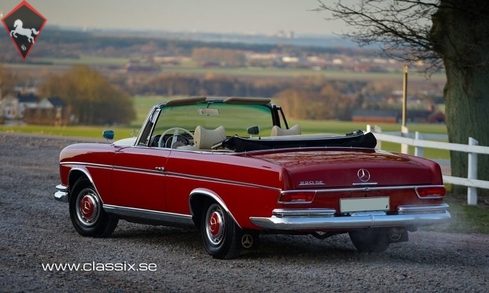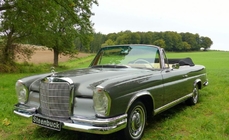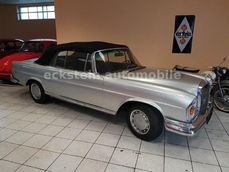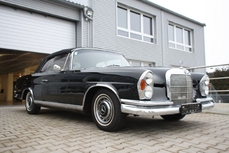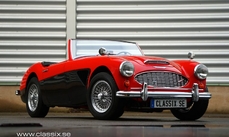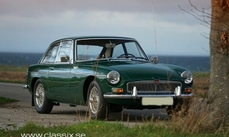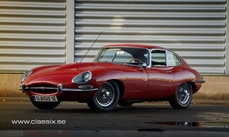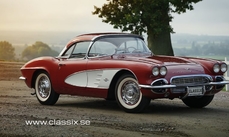Mercedes-Benz 220SE Cabriolet w111 220SE Cabriolet in red with beige leather 1963
General description :
There are many models under the Mercedes W111 code, starting with the saloon cars already in 1959. However, the Mercedes Coupe and convertible cars started with 220SE in 1961. Mercedes then later came with a 250SE, later on a 280SE and the final model was the Mercedes 280SE 3.5 with 200hp. From the Mercedes 220SE Cabriolet that we see here today, there were just over 2700 cars produced (including coupes).
Exterior: It is not easy to make a beautiful convertible that is able to seat four people. Nevertheless, I think the Mercedes 220SE Cabriolet looks amazing driving down the road, even when the roof is in closed position. The black convertible cloth top has been fitted to the car in recent years and looks very good. What also is nice is that it is very quiet in the car while driving for being a convertible. The chrome all around the car is just beautiful, while the paint is chipped in several places. Some smaller dents can be seen, but the shine is still there.
Interior: The W111 Mercedes 220 SE Cabriolet still has the original beige leather interior which is still nice and soft and has most likely had a colouring some time during its life. The wood panels have also been restored at some point and are in excellent condition. Just like all the instruments that work perfectly. The trunk area is in order and the original spare wheel and jack can be found there.
Engine: The 120hp straight six engine used in Mercedes 220 SE Cabriolet feels surprisingly strong. Driving around with the top down, there is rarely need for more power. Power is delivered to the rear through a four speed gearbox that is firm and distinguished. It is a big car, but it handles well due to proper Michelin tyres. Otherwise, the mechanics is up-to-date and there is no strange noises.
History: On the 24th of May in 1963, the first happy owner drove away in this Mercedes 220SE Convertible from the dealership. He or she kept the car until 1986 when the second owner came about. In 1995, it came to a Mercedes dealership in Stockholm and stayed there for 6 years. Until it again in May 2001 came to the present owner who has been caring for this car for the last 21 years. The counter is showing 38,700 and for sure that is turned over at least once. This car will not win you any concours price. But, if you are looking for a super elegant and stylish classic Mercedes Convertible — A car that lets you bring your friends or the entire family when you head for the beach. Something you can leave on the parking lot in town without being nervous. In other words, a sound classic just for fun. — then perhaps, this Mercedes 220SE Cabriolet is for you.
Make:Mercedes
Model:220SE Cabriolet
Km:138000
Transmission:4-Speed Manual
Manufactured in:Germany
Horsepower/kw:120
Condition:3
1963 Mercedes-Benz 220SE Cabriolet w111 220SE Cabriolet in red with beige leather is listed for sale on ClassicDigest in Saxtorp by Classix by Schiebler Scandinavia AB for €85000.
Car Facts
Car type : Car Make : Mercedes-Benz Model : 220SE Cabriolet w111 Model Version : 220SE Cabriolet in red with beige leather Engine size : 0.0 Model Year : 1963 Sub type : Convertible Location : Saxtorp Vehicle Registration : Undefined
85000 €
Seller Information
Classix by Schiebler Scandinavia AB
Classix by Schiebler Scandinavia AB
+46 707 658904
Classix by Schiebler Scandinavia AB
+46 707 658904
People who viewed this Mercedes-Benz 220SE Cabriolet w111 also viewed similar Mercedes-Benz listed at ClassicDigest
Other cars listed for sale by this dealer
About Mercedes-Benz
In the annals of automotive history, the journey of Mercedes-Benz is a tale that unfolds with the ingenuity of its founding pioneers. In the year 1886, Karl Benz crafted the Benz Patent Motorwagen, a creation that would go down in history as the world's inaugural automobile. Unbeknownst to him, this moment marked the genesis of what would evolve into the most illustrious premium car manufacturer globally. The financial underpinning of this pioneering venture, interestingly, was provided by Karl Benz's wife, Bertha Benz, demonstrating a remarkable partnership that would set the tone for Mercedes-Benz's legacy.A parallel narrative emerged not far away, as Daimler-Motoren-Gesellschaft, founded by Gottlieb Daimler and Wilhelm Maybach, entered the scene. In 1901, they unveiled their automobile under the now-famous moniker "Mercedes," meaning "godsend" in Spanish. This name was bestowed upon the car at the behest of Emil Jellinek's daughter, the distributor for Daimler-Motoren-Gesellschaft. The wheels of innovation were set in motion.
Fast forward to 1926, a pivotal year that witnessed the merger of Daimler with Benz & Cie., culminating in the birth of Daimler-Benz. The amalgamation saw the adoption of "Mercedes-Benz" as the distinguished trademark for their automobiles, fusing the legacies of two visionary entities into one.
Contrary to perceptions of conservatism, the trajectory of Daimler-Benz unfolds as a chronicle of industry firsts. From the introduction of the honeycomb radiator to the float carburetor, and the pioneering implementation of four-wheel brakes in 1924, Daimler-Benz consistently pushed the boundaries of automotive innovation. The diesel-powered Mercedes-Benz 260 D in 1936 marked the inception of diesel engines in passenger cars. The iconic Mercedes-Benz 300SL Gullwing made history as the first car with direct fuel injection, albeit the Gutbrod's tiny 2-stroke engine can claim precedence.
Safety innovations became a hallmark, with Béla Barényi's patented safety cell design in the "Ponton"-models in 1951, featuring front and rear crumple zones. The W116 450SEL 6.9 saw the introduction of the Anti-Lock Brake system (ABS), another pioneering safety feature. From the first production airbags and beyond, the legacy of "firsts" continued to be etched into the fabric of Daimler-Benz.
Over its centennial journey, Mercedes-Benz has not merely produced cars but has sculpted automotive icons. The SSKL, 710 SSK Trossi Roadster, 770K Grosser, 540K Spezial Roadster, 300SL Gullwing, w100 600 Pullman, w111 280SE 3.5 Flachkühler, w113 230SL Pagoda, w109 300 SEL 6.3, and w201 2.3-16 Cosworth stand testament to the brand's commitment to engineering excellence.
The roaring Silver Arrows, or "Silberpfeile," including the W 25, W 125, W154, W165, and W196, created a legacy of dominance on the racetrack. These machines were not merely cars; they were expressions of precision, speed, and an indomitable spirit that left their competitors in the dust.
As Mercedes-Benz marches into the future, it does so not just as an automaker but as a custodian of a legacy, a torchbearer of innovation, and a beacon of automotive excellence. The road ahead is sure to witness the continued fusion of cutting-edge technology, timeless design, and an unwavering commitment to setting new standards in the world of automobiles.
One luminary figure who left an indelible mark was Béla Barényi, often heralded as the "father of passive safety" for his pioneering work in safety engineering. His patented safety cell design, featuring front and rear crumple zones, became a hallmark of Mercedes-Benz's commitment to occupant safety, setting new standards that reverberated throughout the automotive world.
Moving through the chronicles, the collaborative genius of Wilhelm Maybach, alongside Gottlieb Daimler, laid the foundation for Daimler-Motoren-Gesellschaft. Their innovations not only birthed the first Mercedes but established a culture of relentless pursuit of technological excellence that remains integral to Mercedes-Benz's DNA.
In the post-merger era of 1926, Ferdinand Porsche emerged as a prominent figure within Mercedes-Benz. His work on the Mercedes-Benz S-Type, a supercharged race car, garnered acclaim and set the stage for a legacy that extended far beyond the marque. Porsche's impact would later extend to his eponymous company, but his influence at Mercedes-Benz during those formative years was pivotal.
As the 20th century progressed, the legendary Rudolf Uhlenhaut emerged as a key figure. Uhlenhaut, an accomplished engineer and the driving force behind the iconic Silver Arrows, played a crucial role in Mercedes-Benz's dominance in motorsports. His engineering prowess and attention to detail were instrumental in creating some of the most formidable racing cars of the era.
In the latter half of the century, figures like Bruno Sacco, the head of design at Mercedes-Benz from 1975 to 1999, left an indelible imprint on the brand's aesthetic identity. Sacco's design philosophy, characterized by clean lines and timeless elegance, shaped iconic models like the W126 S-Class and the W201 190E, solidifying Mercedes-Benz's reputation for luxury and sophistication.
The narrative would be incomplete without acknowledging the contributions of engineers like Hans Scherenberg, whose leadership in the 1970s ushered in a new era of technological innovation at Mercedes-Benz. Scherenberg's tenure saw the development of groundbreaking technologies, including the Anti-Lock Brake system (ABS) and the introduction of airbags in production cars.
